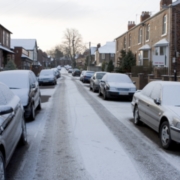Winter is Coming
For road-users, the winter nights can be dark and full of terrors. David Mazurke, Group Manager of Highways, Street Lighting, Gullies and Winter Maintenance for the City of Bradford Metropolitan District Council talks us through the difficult task of maintaining Bradford’s roads in arctic conditions.
Bradford lies in the middle of the United Kingdom just to the east of the Pennines with a population of 530,000. One of the lowest points of Bradford is the City Hall which is 300 feet above sea level. This is is why Bradford is quite unique when compareded with winter maintenance operations of other major cities in Northern England.
The geography and topography of the district makes the winter maintenance operation challenging, most notably because of the large number of settlements which are located above 500 feet altitude; large residential areas are built on these hillsides. One of the highest densely populated areas is Queensbury. It has a growing population of 20,000 that live 1,000 feet above sea level, basically on a mountain. The town or village has two main arterial roads going through it. Even though the winter of 2017 – 2018 was the worst for several years, the Pennines side of Bradford - where over 100,000 residents live - experiences snow conditions every year. However, if you reside further east of the city in the historic tourist area of Ilkley you did not see snow for several years until January 2018, such is the diversity and severity of the weather patterns in Bradford.
These differences of altitude mean that on the highest ground temperatures can be 2 to 4 degrees lower which makes a big difference in winter decision making. A meteorologist who lives in the area recorded 57 snow days over the winter period. Indeed, Living on the Pennines side of Bradford, you’d sometimes be mistaken for living in Winterfell, capital of the North in television epic Game of Thrones.
The Highways teams treat over 700 miles, this accounts for 62% of the network on their priority 1 network from October to the end of April operating from four depots with 24 gritters. During the harsh winter of 2017 – 2018, teams treated the network over 22 weeks out of the 27 weeks on standby. The total of salt used was close to 20,000 tonnes for the period.The priority 1 network was treated on 92 occasions.
Leeds is only 10 miles from Bradford and grits 43% of their highways network with a population of 700,000. However, most of the area is, on average, between 200 and 300 feet above sea level, Though it has high altitude areas, these do not have significantly high populations.
Calderdale, another area that borders Bradford, has similar terrain to Bradford with a smaller population of 209,000 and grits over 60% of their network. Kirklees, also similar in geography, grits 53% with a population of 434,000 and Sheffield grits 70% with a population of 645,000. Wakefield grits 40% with a population of 332,000.
With car ownership increasing, some residential areas now average two cars per household. Combined with major financial cutbacks in highways services and winter gritting, these developments are putting serious pressure on all authorities.
Over the last three years, Bradford, Calderdale and Sheffield faced budget reductions in their winter maintenance pot and the consequences were dire. As a results, roads removed from existing routes were swiftly re-instated.
During the severe weather Bradford Council used its website, Facebook, Twitter, Instagram, media releases and email updates to share timely information about service disruptions, planned gritting, advice on how to help vulnerable people, and photos of staff and local people working hard to help others. This brought a friendly touch to the messages, which no doubt had a positive impact on the public’s patience in these challenging times.
It is sometimes impossible in severe weather events for all managers in winter operations to cope with the demand from the public to grit every road and even cul-de-sacs. It is not only the public demanding but elected members and senior officers, who start to exert pressure on the command centres of the gritting teams.
An initiative through the Bradford MDC area was carried out on creating greater community resistance during the summer of 2017 and 2018. The Bradford area is surrounded by 19 Parish/Town Councils. The majority of these councils lie in the urban areas. Over the last 20 years their areas have seen major residential development with thousands of houses built on hillsides of high altitudes and above snow lines. Their demand for more gritting services cannot be met. To mitigate these problem meetings were held with Parish/Town councils in an evening with a PowerPoint presentation of the highways gritting operation. Plans showing routes were also displayed. All the sessions were well received and good local feedback was used in our planning strategy for future route planning.
The main theme of each presentation was to encourage the councils to look at setting up their own community teams to manage and purchase grit bins in their difficult areas. The councils were offered grit bins to buy at £100 each and any subsequent refills required were charged at £50. The Parish/Town Councils surveyed their own areas and decided on the location of the grit bins which are then verified with the highways team.
The scheme has proved to be very successful with over 30 grit bins ordered for the winter season of 2018 -2019. The management of these grit bins is essential for this type of project and this has also been undertaken by the Parish/Town Councils. Bradford Council has over 550 grit bins. These were on the network and most of the this salt goes on the drives of houses.
Did the harsh winter of 2017 – 2018 with the “Beast from the East” bring any new challenges to the Highways Operation teams across the County? The answer may be no because, since 2010, all authorities/agencies involved in gritting have spent time on improving plans of action and investment in plant and equipment.
However, the power of social media has in my opinion led to a frenzy when the white stuff falls from the sky. This alarm on Twitter and Facebook has only added to the challenges that already existed for the beleaguered gritting teams. The public expectation has increased with the proliferation of social media. The challenges of gritting and keeping the highways and footways clear have certainly intensified over the last 25 years.
Since the mid 1990’s there are more cars on the road, rush hours start earlier and finish later. More school children are taken to school by car. An aging population need to get to health centres and hospitals. Medication in large amounts is delivered to the older population. There has been a huge increase in the number of different recycling bins that now clutter streets which need clearing quickly by refuse lorries. The sharp increase in online shopping has seen the number of white van deliveries increase massively.
Despite these extra challenges there has been some really positive developments in winter maintenance over the last 20 years.
The main improvement has been the weather forecasting. More accurate altitude information is crucial to us in Bradford with the topography and geography of the area. Wind direction, snow fall height, air temperatures and road surface temperatures with the hourly updates from the weather provider Meteogroup, give the winter managers more variables to consider for the gritting operation.
That said, there has been some confusing messages and differences in the severe weather patterns from last winter.
During December 2017 the Met Office held seasonal outlook weather forecast forums for the forth coming months of January, February and March 2018. The Met Office looked in detail at their primary movers of weather which is the North Atlantic Oscillation, Teleconnections (El Niño, severe weather elsewhere for example in the Pacific and the levels of Arctic Sea Ice). All this data was then put through various computer models which predicted there was nothing untoward on the horizon. The actual weather over these 3 months was rather different with most of the UK suffering with heaviest snowfalls for years and several weeks of the “beast from the East” dominating the weather and media outlets.
As the Highways teams across the country carefully plan for another winter, we all need to be aware of one major issue. And that is public expectations are going to be even higher for us in ensuring the roads are passable.
Good luck fellow Winter Highway warriors. The White Walkers are coming.
David gave a presentation on Bradford’s winter gritting strategy at the APSE Winter Maintenance Forum in Bradford on. You can download the presentation here.


.png)



.png)